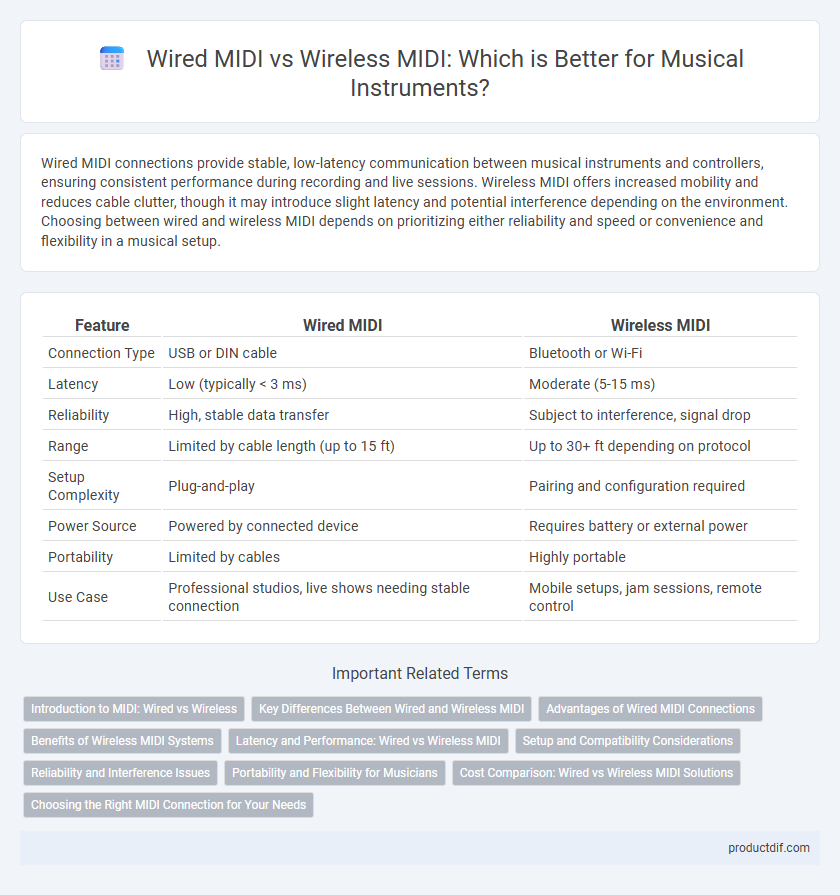Wired MIDI connections provide stable, low-latency communication between musical instruments and controllers, ensuring consistent performance during recording and live sessions. Wireless MIDI offers increased mobility and reduces cable clutter, though it may introduce slight latency and potential interference depending on the environment. Choosing between wired and wireless MIDI depends on prioritizing either reliability and speed or convenience and flexibility in a musical setup.
Table of Comparison
| Feature | Wired MIDI | Wireless MIDI |
|---|---|---|
| Connection Type | USB or DIN cable | Bluetooth or Wi-Fi |
| Latency | Low (typically < 3 ms) | Moderate (5-15 ms) |
| Reliability | High, stable data transfer | Subject to interference, signal drop |
| Range | Limited by cable length (up to 15 ft) | Up to 30+ ft depending on protocol |
| Setup Complexity | Plug-and-play | Pairing and configuration required |
| Power Source | Powered by connected device | Requires battery or external power |
| Portability | Limited by cables | Highly portable |
| Use Case | Professional studios, live shows needing stable connection | Mobile setups, jam sessions, remote control |
Introduction to MIDI: Wired vs Wireless
Wired MIDI connections deliver stable, low-latency communication between musical instruments and devices through traditional 5-pin DIN cables or USB interfaces, ensuring reliable performance in studio and live settings. Wireless MIDI technology enables untethered signal transmission via Bluetooth or Wi-Fi, providing greater mobility and flexibility for performers while still maintaining acceptable latency for most applications. Evaluating wired versus wireless MIDI depends on factors such as latency tolerance, range, interference potential, and setup convenience in various musical environments.
Key Differences Between Wired and Wireless MIDI
Wired MIDI offers faster data transfer speeds and lower latency, ensuring real-time performance with minimal delay, which is critical for professional musicians and live settings. Wireless MIDI provides increased flexibility and freedom of movement by eliminating cables, though it may introduce occasional latency or signal interference due to wireless transmission. Compatibility and power consumption differ, as wired connections draw power from the device itself, while wireless systems require batteries or charging solutions.
Advantages of Wired MIDI Connections
Wired MIDI connections offer superior latency and reliability compared to wireless options, ensuring precise timing crucial for live performances and studio recordings. They provide consistent data transmission without interference from Wi-Fi or Bluetooth signals, making them ideal for complex setups with multiple devices. Wired connections also do not require batteries or charging, enhancing stability and minimizing the risk of connection dropouts during critical moments.
Benefits of Wireless MIDI Systems
Wireless MIDI systems offer unparalleled freedom of movement for musicians, eliminating the constraints of cables and enhancing stage performance. These systems reduce setup time and minimize clutter, leading to a more efficient and organized workspace. Advanced wireless MIDI technology ensures low latency and reliable signal transmission, maintaining high-quality sound and real-time responsiveness.
Latency and Performance: Wired vs Wireless MIDI
Wired MIDI connections consistently offer lower latency, typically under 1 ms, ensuring more reliable timing crucial for professional performances and studio recording. Wireless MIDI systems, while providing greater mobility, often introduce latency ranging from 5 to 20 ms depending on the protocol and environment, which may affect real-time responsiveness. Performance stability is higher with wired MIDI due to minimal interference, while wireless MIDI can experience dropouts and signal degradation in congested wireless spaces.
Setup and Compatibility Considerations
Wired MIDI connections provide reliable, low-latency communication with broad compatibility across traditional synthesizers, controllers, and sound modules, making setup straightforward with standard USB or 5-pin DIN cables. Wireless MIDI systems offer increased mobility and fewer cable clutter issues but may introduce latency and require Bluetooth or proprietary adapters, which might limit compatibility with older or less common devices. Users must evaluate the trade-offs between ease of setup, device support, and potential latency based on their specific musical instrument configurations.
Reliability and Interference Issues
Wired MIDI connections maintain superior reliability by offering a stable, low-latency signal transmission, crucial for professional performances and studio recordings. Wireless MIDI, while offering mobility, is more susceptible to interference from other electronic devices, leading to potential signal dropouts and latency spikes. Choosing wired MIDI reduces the risk of data loss, ensuring consistent synchronization in complex musical setups.
Portability and Flexibility for Musicians
Wired MIDI connections offer reliable, low-latency performance essential for studio settings but limit portability due to cable constraints. Wireless MIDI enhances flexibility, allowing musicians to move freely during live performances or practice without being tethered to equipment. Advances in wireless protocols have minimized latency, making wireless MIDI a viable option for both stage and travel musicians seeking convenience and mobility.
Cost Comparison: Wired vs Wireless MIDI Solutions
Wired MIDI solutions generally offer a lower upfront cost due to simpler hardware and fewer components compared to wireless MIDI systems, which require transmitters, receivers, and batteries or charging capabilities. Maintenance expenses for wired MIDI tend to be minimal, with occasional cable replacements, while wireless MIDI devices may incur higher costs for battery replacements and firmware updates. Budget-conscious musicians often prefer wired MIDI for reliable performance and cost efficiency, whereas wireless MIDI is favored for mobility despite its higher overall expense.
Choosing the Right MIDI Connection for Your Needs
Wired MIDI connections provide reliable, low-latency performance essential for studio recording and live performances, ensuring stable data transmission between instruments and devices. Wireless MIDI offers greater mobility and convenience, ideal for rehearsals or casual playing without cable restrictions but may introduce occasional signal interference or latency. Selecting the right MIDI connection depends on balancing the need for dependable signal quality against the flexibility of wireless freedom based on your specific musical setup and environment.
wired MIDI vs wireless MIDI Infographic

 productdif.com
productdif.com